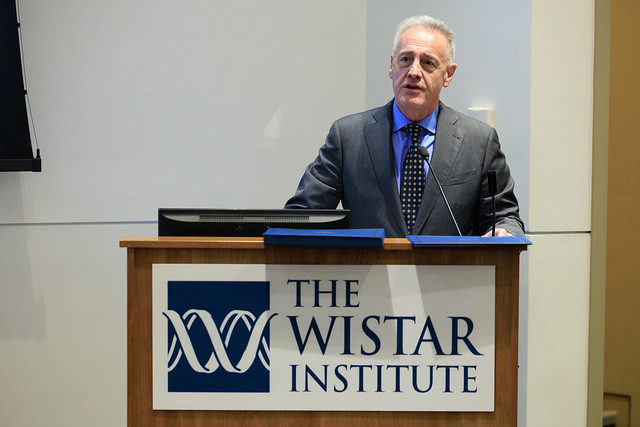This Q&A offers a behind the science peek into some of the long-term effects of COVID on the body influenced by the gut microbiome.
In a paper published in JCI Insight, Mohamed Abdel-Mohsen, Ph.D., associate professor in The Wistar Institute Vaccine & Immunotherapy Center, and collaborators from across the country and world, found that changes to the human microbiome can contribute to certain symptoms of long-COVID. Abdel-Mohsen has been dissecting the “gut-lung” axis for years, and these new findings build upon past research on this system and further identifies a specific phenomenon – the translocation of fungal microbes from the gut and/or the lung to the blood – that could possess clinical relevance in the development of treatments for persistent, long term effects of SARS-CoV-2 on the body.
We had a conversation with Abdel-Mohsen to learn more about the latest knowledge surrounding “leaky gut” and long COVID.
Q: What is the gut microbiome and why is it important in combatting disease?
A: In our gut and other surfaces like our lungs and mouth, there are many microbes that are very important for maintaining human health. In the last decade, it has become very clear that these microbes play a very important role in regulating health and disease. The gut microbiome is a combination of microbes such as bacteria and fungus that occupy a host’s gut. There is a rising number of papers linking the microbiome with diseases such as Alzheimer’s and Parkinson’s. There is a lot of interest in understanding this microbiome, what microbes do, and how to take advantage of this knowledge to design novel strategies to fight different diseases. For example, in addressing cancer, cancer immunotherapy has been associated with changes in composition of the gut microbiome. Another example is that it has now become clear that the microbes in the gut can impact the brain through the gut-brain axis. The microbiome has also been associated with cardiovascular diseases through the gut-heart axis. And the gut microbiome could be involved in a biological cycle with the lung, which itself has a microbiome, through what’s called the gut-lung axis.
Q: What makes long COVID an interesting and particularly complex topic to study?
A: Some people do not completely recover from COVID-19. Between 10 to 30 percent of COVID-19 patients experience either persistent, recurrent, or even new symptoms. If they have these symptoms at least three months after acute COVID-19 infection, it can be called long-COVID or post-acute sequelae of SARS-CoV-2 (PASC). A person’s quality of life is significantly compromised by this syndrome, and some of the symptoms continue for more than a year. This is why we and many others are interested in understanding what might be causing these persistent, recurrent, or new symptoms three to four months after infection.
However, there is no good definition of the phenomena yet. It’s not clear what should be considered long COVID and what is not. There is nothing that the physician can measure to diagnose long COVID. People cannot go and take a test for long COVID, so physicians and researchers rely on self-reporting symptoms from patients, making it very difficult to study because scientists need a very clear system and a very good database. Furthermore, because long COVID is diverse, there are a lot of potential mechanisms that might be contributing to it either in the same individual or within a group of individuals, which makes it complex. One of these potential mechanisms is microbial translocation – some disruption in the gut and/or the lung that leads microbes to translocate which causes inflammation.
Q: What is microbial translocation?
A: Microbial translocation is when microbes translocate through the epithelial barrier of an organ like the gut or lung and go from where they should be to where they should not be – such as the blood. With infection or injury in the lung, like from SARS-CoV-2, comes inflammation in the body and the release of molecules by the host called cytokines.
Cytokines can injure the gut by disrupting the gut’s barrier, allowing microbes such as fungus or bacteria and their byproducts to translocate from the gut to the blood. When the immune system in the blood sees these microbes that should not be there, it reacts by increasing inflammation. This can worsen the original lung disease, which leads to more inflammation and so on, leading to a vicious cycle. This could cause immune exhaustion where this phenomenon of higher inflammation and lower immune function can lead to many diseases.
Q: Can you briefly summarize the findings of your recent research paper?
A: In this scientific collaboration, blood samples were studied from two independent cohorts of long COVID patients from San Francisco and Chicago. We looked at markers of gut barrier permeability and microbial translocation. We found that individuals with long COVID have higher level of markers of gut barrier permeability and fungal translocation compared to individuals who are fully recovered. This level of fungal translocation is correlated with more inflammation and a higher number of symptoms where this individual suffers from lower quality of life.
Specifically, to measure fungus in the blood, we measured β-glucan – a polysaccharide sugar molecule that is on the surface of the fungi. In patients with long COVID, we found levels of β-glucan higher than the normal level in people who are fully recovered or who never got COVID-19. That was interesting for us because the polysaccharide β-glucan can directly cause inflammation. We also did mechanistic experiments and showed that the amount of β-glucan in the plasma of people suffering from long COVID is enough to directly cause inflammation.
Q: How translatable are these findings to understanding the disease and toward the development of COVID therapeutics?
A: Inflammation by fungal translocation may be targeted by drugs. You can block the signaling pathway activated when a fungal polysaccharide binds to the cell, which prompts it to produce inflammation. There are many steps of the signaling pathway in the cell that can be inhibited.
In this paper, we use one small molecule inhibitor to inhibit this inflammation signaling pathway and saw the pathway could be inhibited successfully. In summary, we identified one of the potential mechanisms of long COVID which might contribute to inflammation directly and this mechanism can be targeted with a small molecule inhibitor.
There are many different potential drugs that may be further developed for inhibition. These are potential therapeutic applications that could be tested as soon as preclinical animal models of long COVID are available.
Q: What are some related questions or future directions you would like to see your own lab or other scientists take the findings of this paper in?
A: One of the most common symptoms of long COVID is neurological impact. We are interested in exploring the potential link between the gut-lung and gut-brain axis.
Also, how much does the gut versus the lung contribute to fungal translocation? How can we use antagonists as therapeutic options in a preclinical animal model to treat long COVID as a step to move it to the clinic?
Additionally, we need to understand whether the gut resilience to common stimuli is compromised after acute SARS-CoV-2 infection and whether this contributes to this microbial translocation we observed. I think there are a lot of studies we need to do on the upstream mechanism of this disruption.
Finally, we don’t believe that long COVID is solely caused by microbial translocation. This is probably one out of several mechanisms that contribute to symptoms. It is likely that long COVID is multifactorial in nature and involves multiple processes to some degree, either in the same individuals or in different groups of individuals. For example, how is fungal translocation related to the B cell dysfunction, related to SARS-CoV-2 antibodies, or related to the persistent virus? We eventually need to connect all these mechanisms together to see the full picture.
Q: What would you like readers to take away from this research?
A: The gut microbiome is being recognized as a very important contributor to overall health and conversely in association with many diseases. Persistent and recurrent symptoms have also been reported for SARS-CoV-1, MERS, polio, and many other infections. Understanding mechanisms that contribute to this post-acute infection sequela will be a very important factor moving forward for SARS-CoV2 but also for a plethora of existing and emerging infections. For long-COVID, this is an opportunity for us to understand the disease and how gut microbial translocation is likely a major contributor of these symptoms.
This research was supported by The Campbell Foundation, Commonwealth of Pennsylvania COVID-19 funding, and NIH Cancer Center Support Grant.










